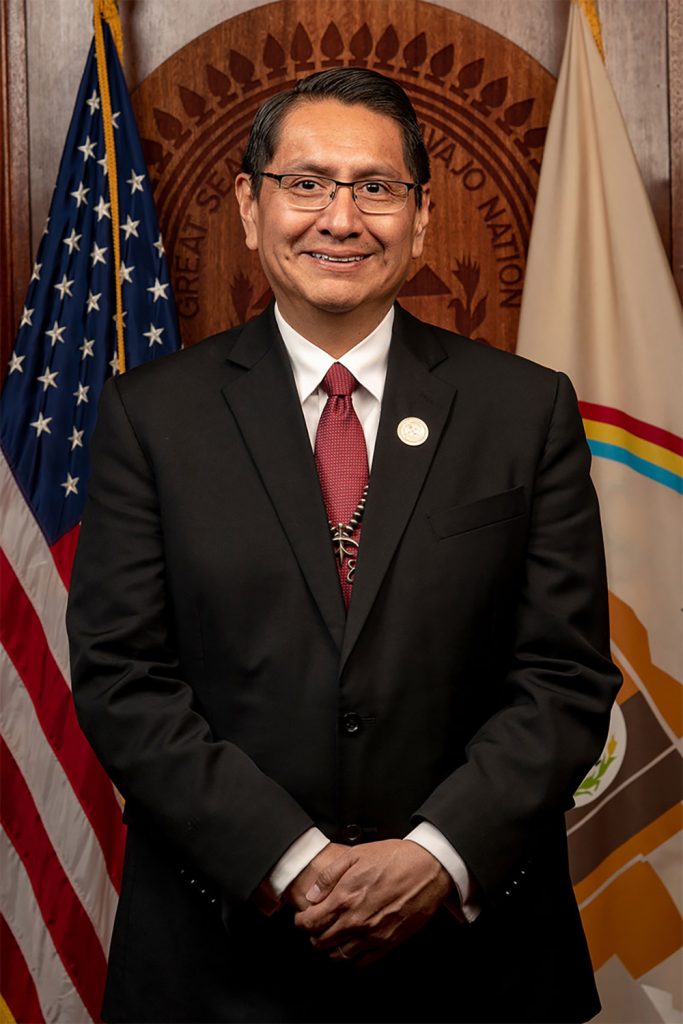President Jonathan Nez updates Sandia on the nation’s COVID-19 journey and recovery

Navajo Nation President Jonathan Nez addressed the impacts of the COVID-19 pandemic on the Navajo Nation and thanked Sandia for its efforts to raise awareness and funding at a critical time for tribal communities during Community Involvement’s Community Engagement Speaker Series, hosted in collaboration with Government Relations.
Sandra Begay, Indian Energy Program lead and Navajo Nation citizen, began the event with a traditional tribal custom, identifying her tribal clans in a ritual intended to help other tribal members understand possible relationships to the speaker.
“There are many new employees, who are now a part of Sandia. It is vital for them to know more about the communities of people surrounding the Labs’ sites,” Sandra said.
Laurence Brown, Sandia’s tribal government relations manager and Navajo Nation citizen, provided context for the visit, stating that there are 574 federally recognized tribes in the United States with 23 of those tribes in New Mexico, and that they have been highly impacted by the pandemic.
In late April, Laurence said a grassroots effort initiated by Sandia’s workforce sparked a Labswide fundraising drive for New Mexico’s hard-hit tribal communities, which accounted for disproportionate numbers of COVID-19 cases. Community Involvement, Government Relations and the American Indian Outreach Committee coordinated The Need is Now fundraising drive to the Native American Relief Fund through United Way.
Its initial goal was $25,000. It had raised $25,000 by the end of the first day, $121,000 at the end of the second day and a final total of $250,000. The Need is Now donations were leveraged to gain additional funds for grants, providing more than $350,000 for food, water and personal protective equipment for the Navajo Nation.
Deputy laboratories director and chief technology officer for nuclear deterrence Laura McGill provided background on the Community Engagement Speaker Series and the importance of the American Indian Outreach Committee, identifying the Navajo Nation as the largest U.S. tribe, with lands as large as West Virginia that span the states of Arizona, New Mexico and Utah. She welcomed Nez and thanked him for participating in the forum.
Nez, the first Navajo president to address Sandia employees, described how the tribe used daily radio broadcasts, town halls and social media to let tribal members know what was going on during the pandemic.
“In time immemorial, we have shared stories of the figures who protect the Navajo people. One in particular is the hero twins, sent to Earth to protect us from the monsters that attack the Navajo people. Fast forward to today and the modern-day monsters are hunger, poverty, vice, alcoholism, drug addiction, diabetes, suicide and now the COVID-19 monster,” Nez said.
Nez said the hero twins were given armor and weapons to fight off these monsters. During the pandemic, the armor were masks and the weapons were information from the Centers for Disease Control and Prevention and vaccines. The community chose to frame the COVID-19 battle in this way, so the elders were able to understand and contribute to reinforcing the need for vigilance against the virus that snuck into homes, communities and the nation.
“A lot of the elders have helped in sharing that story of the twins, fighting off monsters, and the younger generation related to that and put on the armor and the protection that is needed to fight COVID-19,” Nez said.
Sandia and other organizations, volunteers and the nation reached out to all the Navajo outlying communities, including those isolated by long distances, and provided support in terms of food, supplies and personal protective equipment.
“It is a story of the resilience of our people,” Nez said. “People counted us out. Some leaders said the virus may wipe away tribal nations. But we turned that around, with your help, here on the Navajo Nation,” Nez said.
Starting last summer, into the winter holidays, Nez said the Navajo Nation was No. 1 in COVID-19 cases. Now, more than 70% of its eligible residents have been fully vaccinated. With a government mandate for vaccination, 97% of its government employees are fully vaccinated.
Laura thanked Nez for his visit, and said she was pleased to serve as the executive host for the presentation.
“I am always impressed at the level of engagement that the AIOC brings to the Labs and their communities. Thank you to President Nez and to Sandra and Laurence for their remarks and their ongoing dedication to making a difference at Sandia and in our communities,” Laura said.